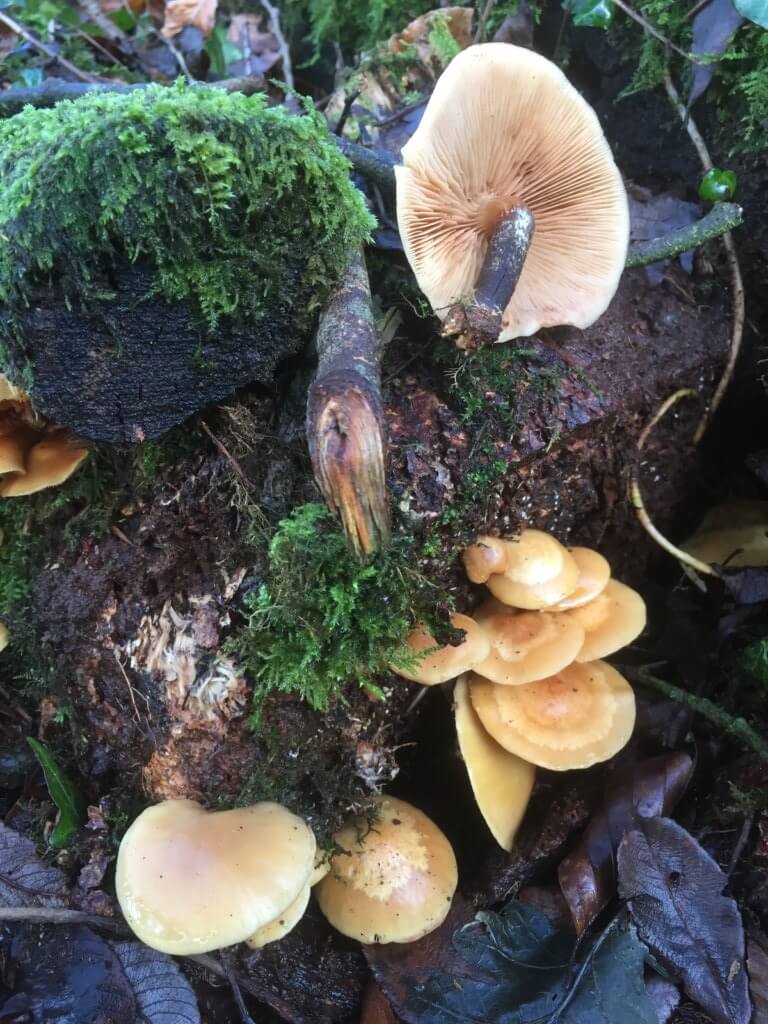
I’ve taken a few calculated risks when eating wild fungi over the years but with this recent find I inadvertently pushed the limits well beyond my comfort zone. They were growing low down on a pile of cut logs at the edge of an old meadow. I initially thought they were Velvet Shanks, a common winter species I have eaten before, so I took a few home. To be extra careful I made a spore print by leaving one of the caps on a piece of paper, under an upturned coffee mug. After a few hours enough of the spores had fallen from between the gills to leave a delicate, pale-brown trace on the paper. So, these were not Velvet Shanks after all, as this species has a white spore print.
Further investigations, mostly online, eventually turned up an exact match for the Sheathed Woodtuft, not something I’d come across before but apparently an excellent edible species. I checked and double checked, and checked again, and put them in the frying pan. And very nice they were too.
A few hours later I stumbled across a reference to a deadly poisonous look-alike species. The Funeral Bell has a name that is equally as disturbing as the better-known Death Cap, and for very good reason – it shares the same deadly toxins. Alarmingly, a couple of websites suggested that the edible Sheathed Woodtuft and the decidedly inedible Funeral Bell could appear so similar that on no account should the edible one be risked. Whilst I was still confident of my identification, sufficient doubt had crept into my mind to make the next few hours pass rather slowly and uneasily.
I’ve read plenty of grim stories about wild food gatherers coming to grief through misidentifications. It’s easy to feel rather smug and tell yourself that you would never be so foolish. This episode was a reminder that the potential for mistakes is never far away, and, if you make one, you may not get a chance to learn from it.
[registration_form]
”A few hours later I stumbled …”
A truly frightening read.
And then there’s Nicolas Evan’s story:
https://www.theguardian.com/books/2011/nov/13/filmadaptations
does one assume you may not be eating this one again Ian?
This begs the question, why take the risk?
The toxicity of fungi is fascinating. Has it evolved as a defence against being eaten by animals? If so it seems surprising that few of the toxic fungal species have developed any form of aposematic colouring (fly agaric would be a possible exception to this). It is also notable that fungal fruiting bodies are eaten by a wide range of invertebrates including slugs, flies, moths and beetles who do not appear to be much troubled by the toxins. I believe that toadstools of various species, including species considered highly toxic to humans, are sometimes eaten by various mammals including squirrels, rabbits and various rodents.
It is a fascinating subject. Caps nibbled by wildlife were once taken as a sign of edibility for humans with sometimes fatal results. I love the varied ways in which the different toxins in fungi take effect. Some kill everyone, others seem to have an adverse effect on some people but not others, some are fine on their own but react badly with alcohol. Then there are toxins that are fine until a certain lethal threshold is reached, often after apparently safe eating over many years. There are also the species that are taken recreationally for the bizarre effects they have on the human brain. It’s all very strange.
Paul – the trouble is I’m even more certain I know what they look like now.
Ed – I’m not sure – why take a risk with anything, but we all do